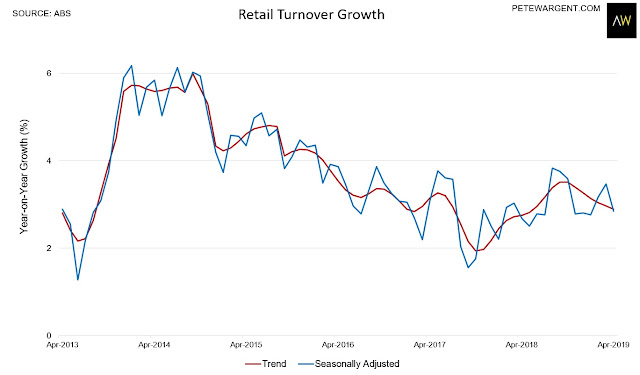Retail soggy
Retail volumes fell in the first quarter of 2019, and now retail turnover in the first month of Q2 was also marginally negative in seasonally adjusted terms.
Taking a more sanguine view, growth slowed to 2.84 per cent over the year.
The near-record low in established housing market turnover has been reflected, naturally enough, in a crunch for household goods retail, particularly including hits for furniture and electronic goods.
Clothing and discretionary eating out were also weak, but department stores have seen somewhat better results.
Hardware purchases are inversely correlated with housing market activity (h/t Wilsons) and have fared rather better.
The story around the traps is mixed.
Population statistics rarely pick up interstate shifts on a timely basis, but the demand shift north to Queensland is clearly reflected in the 6 per cent annual growth in turnover for the Sunshine State.
Things have been far more subdued elsewhere, and especially in the recessionary Northern Territory, where turnover was crunched 4.5 per cent lower over the year.
Online retail accounted for 5.7 per cent of turnover, up from 5.4 per cent a year earlier, as Aussies increasingly shop online.
The arrival of Amazon Australia is just one more factor applying downwards pressure to consumer price inflation, alongside now falling oil prices.
---
Australia recorded a bonanza trade surplus in Q1 - the highest ever at $13.6bn - with international trade set to add a modest 0.2pps to GDP for the first quarter.
This was largely thanks to iron ore, gold, and other metals, though soft imports played a role too.
Net foreign debt remained approximately steady as a share of Australia's GDP.






